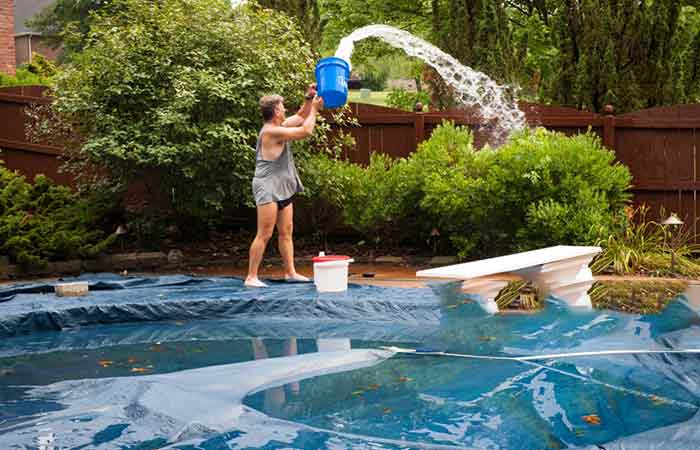Automatic Pool Covers: Choosing the Best for Inground Pools Guide
An automatic pool cover is among the best investments for your inground or aboveground swimming pool. Not only will it keep your pool cleaner, cut down on maintenance, and retain heat, but it also provides an extra layer of safety and security.
This guide will walk you through all you need to know about auto covers, including what they are, how they work, parts, types, top brands, how to choose the right one, installation and maintenance tips.
Automatic Pool Covers: Basics
What is an Automatic Pool Cover?
It is a powered cover that you can extend or retract at the push of a button or flick of a switch. It sits on the pool’s surface and completely seals off the water when closed.
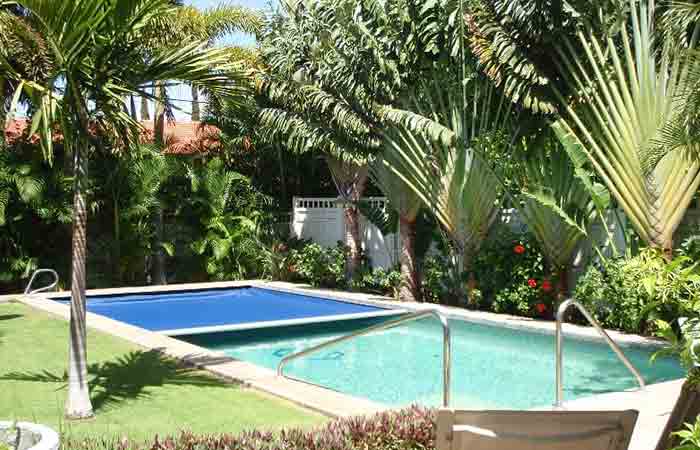
Parts of An Auto Pool Cover
Here are the main components of an automatic pool cover system:
Controller – This control panel or switch activates the opening and closing of the cover. It is usually a keypad, touchpad, or switch mounted on a nearby wall or post. Pressing buttons for Open or Close initiates the cover retraction or extension.
Housing – This deck or recessed box stores the electric motor and mechanical drive components. The cover fabric neatly rolls up into the housing when opening the pool.
Lead Edge – This front metal or plastic bar attaches to the pool cover fabric. It pulls the cover out of the housing when opening and rolls the fabric onto itself when closing the cover.
Tracks – Guide rails mounted into the pool coping or deck along the sides. The lead edge rolls along these tracks, keeping the cover aligned perfectly as it opens and closes.
Gliders/Wheels – Wheels or low-friction gliders mounted under the lead edge bar. They roll in the tracks for smooth movement.
Cover Pump – This safety pump is usually placed on the closed cover and hooked to a GFCI (ground-fault circuit interrupter) outlet. This removes any standing water on top and is critical for safety.
Cables – Steel cable, nylon, or poly ropes that attach to the lead edge and spool up on reels in the housing to retract the cover when opening.
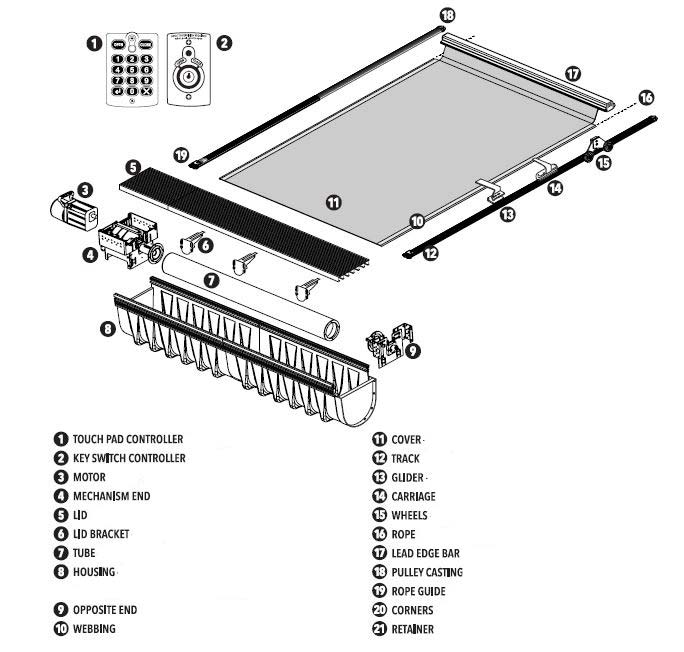
How an Automatic Pool Cover Works
An automatic pool cover uses a pulley system with two reels connected by cables or ropes running through tracks along the pool edges. A motor turns the reels to extend or retract the vinyl cover fabric.
One large reel on one side stores the actual cover material; the other smaller reel holds the cables.
When opening the cover, the motor unwinds the cables from the small reel, pulling the cover off the large reel to retract it.
When closing the cover, the motor winds the cables to pull the cover back across the pool onto the large reel. This automatic pulley mechanism allows you to open and close the pool cover with a button rather than manually.
Types of Automatic Retractable Pool Covers
There are several types of automatic pool covers, including electric, hydraulic or solar (based on the energy source that powers their operation), on-deck, recessed, and under-coping (based on how the track systems are mounted to the edge of the pool)
Hydraulic Automatic Pool Cover
A hydraulic automatic pool cover system is a type of automatic pool cover that uses hydraulic (liquid fluid) power to open and close the cover. The system consists of a hydraulic motor, a hydraulic pump, and a hydraulic cylinder.
When the cover needs to be opened or closed, the hydraulic motor is activated by turning a key or using a remote control.
The hydraulic pump generates hydraulic pressure, which is transmitted to the hydraulic cylinder. The hydraulic cylinder converts the hydraulic pressure into mechanical force, which moves the cover.
This type of system is ideal for larger pools where more power is needed or access to the pool’s electricity is limited or unavailable.
Overall, a hydraulic automatic pool cover system is a reliable option for owners who want to ensure their pool’s safety and security while reducing maintenance and energy costs.
Electric Automatic Pool Cover
An electric automatic pool cover system is a type of automatic pool cover that primarily relies on electricity to open and close.
It comprises an electric motor, the component that provides the power to roll up or retract the vinyl pool cover, and a mechanism to activate the motor, usually a push button, switch, or touchpad control.
You only need to activate the motor to open or close this type of cover. Once you’ve turned on the motor, the pool cover automatically rolls across the pool area with the help of two tracks on either
On-Deck Covers
Also referred to as toptrack or deck-mount toptrack, these covers have the track housing on top of the pool deck near the coping. This provides easy access for maintenance and repairs since the system components are out in the open.
With this setup, it means deck modifications are more straightforward compared to recessed housing. They fit almost any shape or size of an existing pool.
On-deck tracks provide the best overall value, balancing easier installation and maintenance with lower costs. The downside is that the track and cover housing are visually prominent and do not retract fully out of sight.
Recessed Covers
Also referred to as flush track or recessed toptrack, this type of cover has its track housing buried in a trench in the pool deck. The cover disappears into a housing recessed below the deck. This provides a sleek, flush/hidden appearance when the cover is fully retracted. This cover fits both new and existing free-form or rectangular pools.
However, installation is more complex, requiring excavation of the pool deck and waterproofing of the recessed trench area. Accessing the track system for servicing can also be difficult with the housing buried.
Under-Coping Covers
Sometimes called the recessed undertrack, these covers have the track mounted inconspicuously under the pool’s coping with the mechanism housed below the deck.
The mechanism, track, and cover are hidden from view when the cover is open. In addition to hiding the cover system, this offers the most streamlined look possible.
While undertrack covers are aesthetically appealing, installation requires removing and replacing the coping stones. The track is also not accessible for service once the coping is restored. Any track repairs or replacement would necessitate redoing the entire coping around the pool perimeter.
Under-coping covers cannot fit on any pool; they fit only on pools designed to accommodate them.

Pros of Automatic Pool Covers
Investing in an automatic pool cover offers numerous advantages that enhance the overall experience of pool ownership. The following are the compelling benefits these covers bring to your swimming pool and peace of mind.
Safety
Safety is paramount, especially if you have children or pets. Many users think safety is the primary reason they consider these covers. Here is how auto covers provide a vital layer of protection:
- Accident prevention: When closed, these covers create a sturdy barrier that prevents accidental falls into the pool. Many covers also come with safety sensors to detect movement on the cover’s surface.
- Peace of mind: Knowing that your pool is securely covered when not in use gives you peace of mind, particularly when you’re away from home.
Energy Savings
One of the most significant advantages of automatic pool covers is their contribution to energy savings. Here’s how they achieve this:
- Heat retention: Automatic pool covers act as an insulating layer, preventing heat from escaping your pool water. This means your pool stays warmer for longer periods, reducing the need for constant heating.
- Reduced evaporation: They significantly reduce water evaporation, a major source of heat loss in outdoor pools. This can lead to substantial savings on energy bills.
Reduced Maintenance
Pool maintenance can be time-consuming and costly, but automatic pool covers can alleviate many of these concerns:
- Debris protection: By keeping leaves, twigs, pollen dust, and other debris out of your pool, these covers reduce the need for frequent skimming and cleaning
- Chemical savings: With less exposure to sunlight and debris, your pool’s water quality remains more stable, reducing the need for excessive chemical treatments.
Extended Pool Season
Automatic pool covers can extend your swimming season, allowing you to enjoy your pool for a more extended period throughout the year:
- Warmer water: By retaining heat, these covers keep your pool water comfortable, even during cooler seasons.
- Less maintenance: With reduced debris and fewer water temperature fluctuations, opening your pool early in the spring and keeping it open later into the fall becomes more practical.
Environmental Benefits
For those with eco-conscious values, automatic pool covers offer environmental advantages:
- Water conservation: Less evaporation means you use less water to maintain your pool’s water level.
- Reduced energy consumption: By decreasing the need for pool heating, these covers help reduce energy consumption and your carbon footprint.
- Chemical use: With stable water conditions, you’ll use fewer pool chemicals, which can harm the environment when overused.
Cost Efficiency
While the initial investment in an automatic pool cover may seem significant, the long-term cost savings are substantial:
- Energy bill reduction: Lower heating and operational costs translate into ongoing savings.
- Reduced maintenance expenses: Less on pool cleaning, chemical treatments, and water replacement.
- Extended pool lifespan: By protecting your pool from debris and temperature fluctuations, you can extend its lifespan by postponing costly repairs or renovations.
- You may not need a fence: In some states, installing an auto cover exempts the need for a fence around the pool and yard. So, the cover can save on the high costs of fence installation.
Can Serve as a Winter Cover
Some pool owners use automatic covers as their winter covers. This can work if your region does not experience heavy rains and snow. However, because an automatic pool cover is not porous, rain and snow will pool on top of the solid vinyl cover and must be manually pumped off periodically.
Cons of Automatic Pool Covers
While automatic pool covers are great, they aren’t perfect. Before buying an automatic cover, consider the disadvantages of one.
Initial Cost
One of the most significant drawbacks of automatic pool covers is their high upfront cost, which can be a substantial investment for pool owners. These covers can cost you $15,000 on average. This encompasses the cover system, installation, and any additional components.
Compared to basic manual covers costing $2,000-$3,000, automatic covers are far more expensive up front, running 2-3 times the price or more.
For those with limited budgets or building a new pool, this initial price tag can be prohibitive and prevent owners from purchasing an automatic cover.
Not only are automatic covers pricey from the outset, but repair and upkeep expenses are also significant over time.
Between the steep initial investment and ongoing maintenance costs, automatic pool covers represent a major financial consideration that can be out of reach for some owners.
Ongoing Maintenance
Automatic pool covers, like any mechanical system, require regular maintenance. This includes cleaning the cover, lubricating moving parts, and inspecting for wear and tear. Neglecting maintenance can lead to operational issues and reduce the cover’s lifespan.
Additional periodic maintenance is needed to manually pump off rainwater that accumulates on top of the closed cover.
Rainwater Accumulation
Unlike winter covers that are porous to let the snow and rain seep into it and fill the pool, automatic pool covers are not permeable, meaning rainwater can collect on the surface of the closed cover if you don’t have any way to drain the water.
While automatic pool cover can handle a bit of weight, too much rainwater can overload the cover system, resulting in damage. You have to get rid of the excess water periodically using a pool cover pump. You will have to spend time and effort removing standing water.
And during the winter, the snow can be too heavy if you get a lot of snow. A lot of snow may tear the ropes on the cover or even affect the entire system. A good pool pillow helps solve problems with ice on your winter cover.
Shape Limitation
Standard rectangular automatic covers best fit rectangular pools. On unconventional curved or shaped pools, the cover may not blend in aesthetically or fully seal the unique outline efficiently. This can create unsightly gaps and a mismatched appearance.
The pool shape often needs to match the cover shape to maximize visual appeal. So, shape limitations rule out adding covers on creatively designed pools, restricting design freedom.
Mechanical Issues
Automatic covers are prone to mechanical issues like the cover getting stuck, gears wearing out, cables tangling, sensors malfunctioning, and motor failures, which can be pretty frustrating.
Because they are not DIY-friendly, repairing these problems often requires calling a technician. You may also have to purchase replacement parts.
Cheaper automatic cover systems tend to have more frequent mechanical problems.
Restricts Chemical Movement
When using an automatic cover, pool chemicals like chlorine can become more concentrated over time as they remain trapped in the covered water. This concentration may damage metal components in the cover mechanism.
However, you fix this issue by carefully adjusting the chlorine dosage to prevent overdosing while maintaining proper water sanitation.
Excessive Heat Retention
Efficient automatic pool covers are excellent at retaining heat, which is beneficial in cooler weather.
However, during scorching summer weather, the cover’s insulation can lead to the pool water becoming uncomfortably overheated for swimming. This excessive heat retention may be a drawback during heatwaves.
Shorter Life Span
The lifespan of an automatic pool cover is around seven years, which is relatively shorter compared to other options.
Weight Limits
The covers also have weight limitations, usually supporting 50-100 lbs spread over the surface. Exceeding this risks damage to the fabric. Warning labels clearly indicate the cover is not meant for walking on.
Risk of Entrapment
Though not a common concern, children or pets can be caught under the covers as they close, leading to injury or drowning in some cases.
While high-end models have safety features to prevent this, less expensive versions may lack auto-reverse and other mechanisms. Supervision is a must when operating an automatic cover.
Best Automatic Pool Covers & Brands
Here are the top models and brands of automatic pool covers:
Coverstar
Coverstar is a well-established name in the automatic retractable pool cover industry. Covers from this brand consistently rank among the highest in terms of safety, durability, and functionality. They offer a range of pool cover options to suit various pool sizes and designs.
Coverstar’s Eclipse cover system holds more exclusive features than any other model, including oversized pulleys, more enormous drive trains, and stainless-steel parts.
It also comes with ten standard fabric options and three different track options. Its mechanism is covered under a 20-year limited warranty.
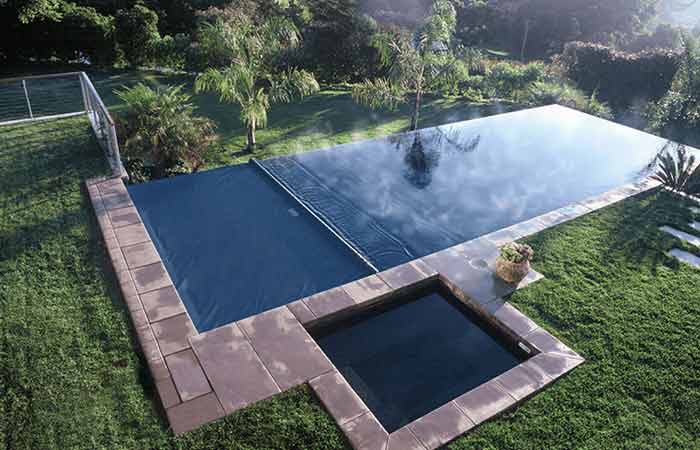
The Eclipse is one of the strongest, most reliable pool cover models and the best protection for your loved ones and your pool for years to come.
Standard features of all coverstar covers include;
- Sealed Motors: Motors are entirely sealed to allow safe use and protect your pool cover from rain, splashing water, or overfilling.
- PowerFlex Ropes: PowerFlex ropes work to absorb shock and self-adjust for reliable performance. PowerFlex ropes include a 2-year, no-break warranty.
- Durable Fabric: Coverstar fabric is made from specially formulated heavy-duty vinyl fabric. This high-performance fabric is available in 10 colors and provides ultraviolet protection, and mildew and chemical resistance and a 7-year warranty.
- Heat-Sealed Webbing: This is over twice as strong as competitive webbing sewn to a cover.
- Keyed Safety Switch: You can choose from five cover control switch options: three touchpads and two locked manual switches. You can also select a switch option that will allow you to receive safety alerts when your pool cover is opened or closed.
- Sliders: Stronger than the competition and eliminate pool cover binding.
- Gears: Feature oversized gears to eliminate drive-train breakage.
Pros
- Durable and strong built-materials
- Plenty of choices for colors
- Deliver the ultimate in safety, elegance, and convenience.
- Custom-built to fit your pool, so no matter your pool design, they can construct a cover that fits.
- Variety- four models to help you find the best cover to fit your style.
- Outstanding warranties
Cons
- Overwhelming upfront cost.
- Automatic pool covers require regular maintenance to keep them in good condition, which can be time-consuming and costly.
- Some customers have reported that the Coverstar cover is a major maintenance expense.
APC (Automatic Pool Cover Inc)
With years of experience constructing automatic pool cover systems, APC produces high-quality, premium covers for safety and convenience. Their systems incorporate real-time diagnostic features to prevent problems and quickly identify any potential maintenance needs.
Built using robust commercial-grade hardware, APC units generate over 1500 pounds of torque, allowing for fast opening and closing of the cover in about 60 seconds.
The covers are engineered to meet and surpass industry safety standards (ASTM-1346).
Additionally, APC uses specially coated vinyl fabric on their covers, which is the longest-lasting in the industry compared to other brands.
Other key features of APC’s systems include thick extrusions for durability, electronic torque limit to prevent overrun, sand-infused paint for grip, invisible Invis-A-Rope, and multiple color options.
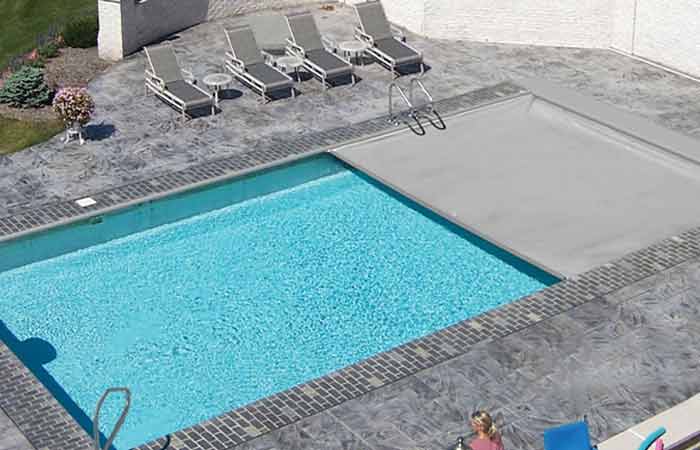
APC’s 365TM automatic pool cover system is designed for vinyl liner pools where owners want the best quality.
It combines a high-performance safety cover and a durable pool coping system. The complete unit includes a poly box, electric motor, flush lid, premium vinyl, hidden cabling, and 5-year warranty.
With a simple mechanical design using industrial-grade components, the APC 365 is one of the most reliable and highest-quality automatic cover systems.
Pros
- Real-time diagnostic features
- Quick opening and closing
- Meets high safety standards
- Industrial grade components and simple mechanics
- Outstanding warrant
- User-friendly interface with personalized security code
Cons
- High price tag
- Requires regular maintenance
- Prone to mechanical issues
Aquamatic’s Hydramatic Automatic Pool Cover
Created by Aquamatic Cover Systems, the Hydramatic is a premium automatic pool cover system designed for reliability and low maintenance. It uses an innovative hydraulic drive mechanism for smooth, trouble-free operation.
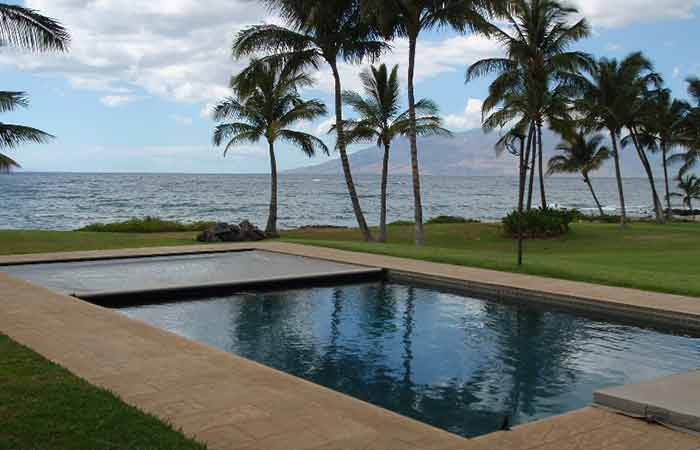
Key Features
- Dual hydraulic motors open and close the cover
- Waterproof design with no electrical parts near the pool
- Built-in rainwater removal system
- Patented pressure relief valves for smooth stopping
- 20-year warranty on the mechanism and 7-year for the fabric
- UL tested and certified to exceed ASTM F1346-91 standards
Pros
- Very reliable and maintenance-free
- It keeps the pool secure and saves on heating costs
- Rainwater removal and chemical screening
- Smooth automatic operation
- Extended warranty coverage for peace of mind
Cons
- Costly initial investment
- Potential for corrosion from pool chemicals
Verdict
The Hydramatic Automatic Pool Cover is a top-of-the-line system known for its safety, efficiency, and reliability. The unique hydraulic drive and extensive warranty make this a premium automated cover option.
However, the exceptionally high upfront cost means it’s best suited for those wanting the utmost in quality and convenience. A lower-priced electric cover system may be the more practical choice for most. But for a maintenance-free top-tier cover, the Hydramatic is hard to beat.
Automatic Solar Blanket Cover Reel/Roller
The Automatic Solar Blanket Cover Reel/Roller simplifies covering and uncovering your in-ground swimming pool. This innovative accessory allows for effortless remote-controlled operation of your solar pool blanket.
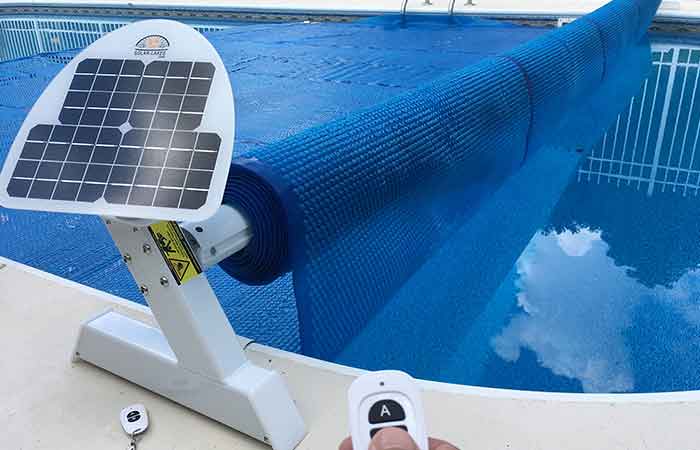
Key Features
- Remote-controlled operation for convenient, hands-free use
- Solar-powered battery for energy efficiency
- Durable, sturdy construction built to withstand outdoor conditions
- It fits rectangular pools up to 20×40 feet with an adjustable design
- Auto-stop mechanisms provide safe blanket movement
Pros
- Affordable compared to automatic covers
- Saves significant time and physical exertion compared to manual methods
- Durable and robust design built to last in pool environments
- Easy installation and intuitive operation
- Solar battery-powered, reducing electricity costs and promoting sustainability.
Cons
- Requires exposure to sunlight for efficient solar charging.
- It may not be suitable for pools with irregular shapes or sizes.
- Blanket can still get dirty/damaged when unrolled
- More expensive than manual reel options
- Requires mounting with proper load support
The Automatic Solar Blanket Cover Reel/Roller takes the hassle and struggle out of handling solar pool blankets. You can open or close your pool cover smoothly and safely with a button.
This innovative accessory is a worthwhile investment for any pool owner looking to reduce maintenance and promote sustainability.
Other auto solar pool blankets worth checking out include;
Pool Boy Powered Pool Solar Blanket Reel
The Pool Boy Reel System is a versatile automatic pool cover designed for durability and flexibility. It features high-strength aluminum construction with a corrosion-resistant powder-coated finish.
The system includes adjustable stands, protective covers, a transformer and power cord, a remote control, a tube kit for pools up to 20’ wide, and a tether kit.
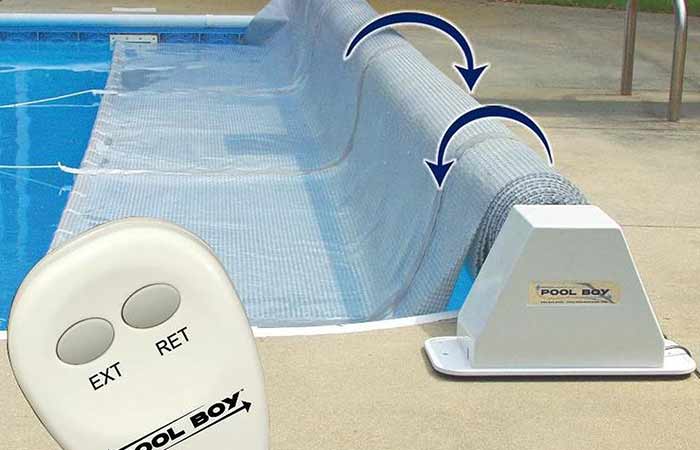
Pool Boy offers multiple mounting options for diving boards and various solar blanket lengths. This allows the system to work with different pool configurations and solar cover sizes. The adjustable components and mounting options provide flexibility and convenience for pool owners.
APR pool cover systems are electric, portable, adjustable speed, and easy to operate multiple times daily. Their unique design offers pool owners the luxury of semi-automated and fully-automated operations without the expense of a built-in swimming pool cover.
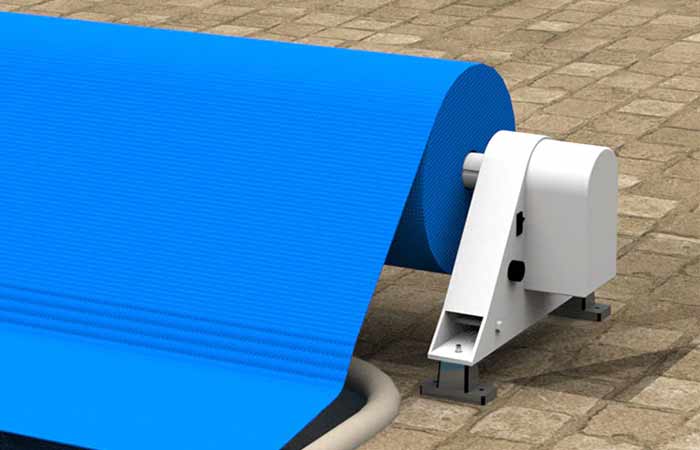
How to Choose the Right Automatic Pool Cover
Selecting the ideal automatic pool cover for your swimming pool is a significant decision that should be carefully considered. In this section, we’ll guide you through a step-by-step process to help you make an informed choice that aligns perfectly with your pool’s specifications and unique requirements.
Assess Your Pool Size and Shape
The first step in choosing the right automatic pool cover is to assess the size and shape of your pool. Automatic pool covers come in various sizes and configurations, so knowing your pool’s dimensions is essential. Measure the length and width accurately and note any irregular features, such as steps or corners.
Consider Your Climate
Your local climate plays a significant role in determining the most suitable pool cover for your needs. Consider the following factors:
- Winter Conditions: If you experience harsh winters with heavy snow and ice, you’ll need a pool cover designed to withstand these conditions.
- Hot Summers: In regions with scorching summers, UV-resistant materials become crucial to prevent cover deterioration.
- Year-Round Use: If you plan to use your pool year-round, you’ll want a cover that provides excellent insulation and heat retention.
Cover Material Quality
Look for materials like reinforced vinyl or heavy-duty fabric that can withstand the rigors of outdoor use, including exposure to sunlight and weather elements.
UV-resistant materials are less prone to fading and degradation over time. They offer long-term protection against harmful UV rays, ensuring your cover remains in excellent condition for years.
Insulated solar blankets help retain heat and withstand weather but are less durable long-term.
Motor Power & Quality
The motor is the heart of your automatic pool cover system. A reliable motor ensures smooth and efficient operation.
For pool owners who plan to frequently open and close their cover daily, choose a robust motor of at least 2HP paired with high-quality corrosion-resistant components and mechanisms rated for repetitive use.
Those who only use their cover occasionally or seasonally can likely opt for standard 1 HP motors to help reduce costs. Regardless of motor size, ensure it meets UL safety standards and has built-in thermal overload protection for safety.
Safety Features
Safety should be a top priority, especially if you have children or pets. Look for automatic pool covers that come equipped with safety features, including:
- Sensors: These sensors detect any movement on the cover’s surface and automatically stop or reverse the cover to prevent accidents. Water sensors stop the motor if any water buildup is detected under the cover.
- Passcode and locking mechanisms: Secure locking systems ensure the cover stays in place, making it impossible for unauthorized access. Passcode protection also helps prevent unauthorized operation.
- Auto-reverse and cover tautness sensors prevent entrapment hazards.
- Battery backups enable cover retraction during power failures.
Warranty Coverage and Customer Support
Check the warranty offered by the manufacturer. A longer warranty period often reflects the manufacturer’s confidence in their product’s quality. Look for generous warranties on:
- Fabrics – at least five years against defects
- Mechanical components, including motor- At least ten years
- Labor – 1-3 years on installation workmanship
Additionally, research customer reviews and inquire about the brand’s customer support to ensure you’ll receive assistance if needed.
Additional Features
Depending on your preferences, you may want to explore additional features such as:
- Remote Control: Look for covers that offer user-friendly remote control options for easy operation.
- Automation Compatibility: Some covers can integrate with home automation systems or smartphone apps for added convenience.
- Aesthetic Customization: If aesthetics are essential, inquire about customization options to ensure the cover complements your pool area.
- Keypads or touchscreens mounted poolside.
- Waterproof remote switches for manual on-site control
- Solar-powered capabilities can heat the water using free solar energy
Other Factors
Budget: Determine your budget for an automatic pool cover. Review both the upfront costs and the operating expenses like electricity needs and the cost for periodic maintenance and repairs.
Check Local Building Codes: Research specific requirements or Work with qualified installers familiar with relevant codes to ensure compliance.
Tip!
Obtain quotes from multiple pool cover providers to ensure you’re getting the best value for your investment. Compare prices, features, warranties, and customer reviews to make an informed decision.
Consider seeking help from pool cover experts or professionals who can provide advice based on your pool’s unique characteristics and your goals.
Remember that investing time in research and assessment now will lead to years of satisfaction and enjoyment with your pool cover.
Automatic Pool Cover Installation
While automatic covers are DIY-friendly, having a professional take care of the installation is highly recommended. Correct placement and securing of the cover mechanism is crucial for proper operation. Here are the key steps:
- Clear the pool area of any obstructions or debris to prepare the space.
- Mount the roller assembly housing the cover fabric and motor along the correct part of the pool edge.
- Ensure the roller assembly is leveled before securing it tightly to the deck stands.
- Insert and align the front cover fabric edge properly into the roller barrel.
- Install anchors around the pool perimeter to tie down the cover edges.
- Complete electrical wiring for the controls, motors, and safety mechanisms.
- Thoroughly test the cover operation and make any adjustments or tweaks needed.
With proper installation following manufacturer specifications, an automatic pool cover can provide you with years of trouble-free service.
Using and Maintaining Your Automatic Pool Cover
Using your automatic cover properly and performing regular maintenance is essential to keep your automatic pool cover in excellent condition and extend its lifespan. Here are some essential use and care tips:
Opening and Closing
- Before opening and closing, remove any obstructions or sharp objects (toys, rocks, dirt, etc.) in the tracks, cover, or housing to prevent damage.
- Retract covers slowly to avoid fabric damage. Close them slowly to prevent bubbles under the cover.
- In windy conditions, partially open covers about 1 foot to allow air pressure stabilization before fully retracting.
- Avoid stepping directly on cover fabrics to prevent premature wear. Step around the edges.
- Ensure the water is halfway up the skimmer before closing to support the cover.
- Use control switches gently – forced or held contacts can fry circuit boards.
Debris Removal & Cleaning
- Promptly clear off leaves, water, and other debris to prevent residue buildup on the vinyl. Even if the cover looks clean, harmful chemical deposits can accumulate over time.
- Regularly rinse the entire cover with a pump to wash away contaminants. This helps extend the life of the fabric.
- Use a soft bristle brush and fresh water to scrub stains. Rinsing alone may not thoroughly remove them.
- Use a small amount of non-detergent cleaners, such as Ivory bar soap, on a wet cloth for oils or stubborn stains. Never use detergents on the vinyl.
- Mix 1 part Clorox bleach with nine parts water to remove algae stains, specifically black algae. Apply this solution directly onto the affected area. Ensure you use regular Clorox and not pool chlorine.
- After cleaning, always rinse thoroughly with fresh water to prevent chemical residue buildup. Let the cover dry entirely before retracting to avoid mildew.
- Clean track channels regularly to remove dirt buildup.
- Rinse metal components to prevent chemical/dirt residue.
Lubricating Components
- Lubricate parts like motors, gears, bearings, and pulleys according to manufacturer specifications. This enhances longevity.
- Take care not to over-lubricate. Excess grease can get on the cover fabric and cause deterioration.
Winter Care
- Before winter, pump or drain all water off the cover and allow it to dry completely. This minimizes weight and prevents ice damage.
- Disconnect and store any switch controls indoors over winter.
- Make monthly inspections of the water level under the cover during winter. Top up as needed.
- Leave the pump on the cover during freezing conditions.
- Keep drainage holes in cover housing clear of debris so water drains freely.
- Always keep the housing lid in place to prevent direct rainwater entry and avoid potential falling hazards.
- Do not allow significant water, snow or ice buildup. A few inches of precipitation can equal over a ton of weight, which risks damage.
- Consider installing reinforced winter support bars if heavy snow loads are expected. This helps disperse weight.
Other Care Tips
- Include slack in the cover to account for shrinkage and rain/snow loads.
- Adjust chemical levels for the covered pool to avoid damage from over-chlorination or high pH.
- Check the owner’s manual for any additional care and maintenance guidelines.
Safety Inspections
- Check the vinyl and stitching for cracks, brittleness, holes or separation indicating deterioration. Repair any wear immediately before it worsens.
- Confirm the cover forms a tight seal around the entire pool perimeter when extended.
- Examine track fasteners, cables, and motors for excessive wear. Replace components as required.
- Check perimeter anchors frequently to ensure the cover stays fully secured.
Tip!
Always follow the manufacturer’s maintenance guidelines and recommendations. These guidelines are specific to your cover’s make and model and are designed to optimize its performance and lifespan.
Professional Maintenance
Consider scheduling regular professional maintenance checks. Professional technicians can identify and address potential issues before they become significant problems. When to call a pro;
- If the cover fails to open or close fully or begins making strange noises.
- Any mechanical failure of the motor or gear system.
- For periodic roller realignment or adjustment to fix tracking issues.
- Major cover repairs like torn panels or damaged connectors.
- If your cover experiences heavy use or harsh weather conditions.
By following these maintenance tips, you can ensure that your automatic pool cover operates smoothly, remains in excellent condition, and provides you with years of hassle-free service. Regular care and attention will also contribute to the safety and efficiency of your pool cover.
FAQs
Here are frequently asked questions about automatic pool covers.
Can you Walk on an Automatic Pool Cover?
Yes, you can walk on an automatic pool cover; it is designed to support a person’s weight in an emergency. However, it is not recommended to walk on the cover regularly, as this can cause damage to the cover and the track system. Only walk around the outer reinforced edges of the cover.
Can you Add an Automatic Cover to an Existing Pool?
Adding an automatic cover to an existing pool is possible, but it often requires some modifications. The roller and track system must be appropriately mounted and integrated with the existing pool deck and coping. Hiring a professional installer is highly recommended for retrofitting covers.
Automatic Pool Cover Off Track
Covers often come off track due to a broken glider, rope, or deck screw. You can use a flathead screwdriver to guide the rope back into the track, but if the problem is more severe, seek professional help from your service company.
Is an Automatic Pool Cover Worth it?
Automatic covers can be a worthwhile investment, depending on your needs. Key benefits are easier maintenance, heat retention, safety for kids, and extending the pool season. But the high upfront cost gives pause. For those wanting maximum convenience and efficiency, automatic covers are worth considering.
How much does an Automatic Pool Cover Cost?
It can cost you between $8,000 to $22,000 or more. The actual price may vary depending on your pool’s size and shape, the track system, specific features of the model, and the installation cost.
Are Automatic Pool Covers Safe for Children and Pets?
Yes, automatic pool covers are designed with safety in mind. Many come equipped with safety features such as sensors that detect any movement on the cover’s surface. If an object is detected, the cover stops or reverses its movement to prevent accidents. The secure locking mechanisms also make it impossible for children and pets to access the pool when the cover is closed, providing an extra layer of protection.
Can I Install an Automatic Pool Cover Myself?
While some automatic pool covers offer DIY-friendly installation options, having a professional handle the installation is generally recommended. Professional installation ensures the cover is correctly installed, aligned, and calibrated for safety and optimal performance. It’s also often required to maintain the cover’s warranty.
Why is the Cover Opening/Closing Crooked?
Slight crooked movement is normal, but have your installation company representative inspect severe misalignment and make the necessary adjustments.
My Cover Doesn’t Move or Stop Midway?
First, check that the electrical supply is on and reset any tripped GFCI outlets. Dirt and debris in the cover tracks can also cause it to bind or jam, so thoroughly clean out the tracks using water or compressed air. Make sure the cables or ropes are not tangled up on the reel, which would inhibit movement.
Heavy rain or accumulated water on top of the cover can also prevent opening, so use a cover pump to remove any excess standing water. Contact your original installation company if the cover does not fully retract or extend after checking these items.
What is the Popping Noise I Hear?
Sometimes, the ropes will pop up when they pass through the different pulleys and onto the rope reel. This is normal and not an indication of trouble.
Why does the Cover seem too Big and Wrinkled?
The extra fabric is vital to the effective operation of the cover. At first, new covers appear wrinkled or oversized, but this is normal, and the wrinkles may smooth out over time.
How long does it take to Open and Close an Automatic Pool Cover?
It typically takes just a few minutes to open or close the cover. The time it takes to open and close can vary depending on the cover’s type and size and the motor’s power.
Do I Need to Remove the Cover Completely to use my Pool?
You do not need to remove the cover to use your pool. Automatic pool covers are designed to partially or fully retract, allowing you to uncover only the pool portion you wish to use. This flexibility provides convenience and allows you to enjoy your pool without needing complete removal.
How Long do Automatic Pool Covers Last?
On average, most automatic pool cover fabrics will last 5-7 years, depending on pool water and chemical buildup, sunlight exposure, and other environmental elements.
If I Drain my Pool or the Water Level gets Low, should I close the Cover?
Never cover your pool if drained, or the water level is above six inches below the skimmer. Doing so could cause damage to the system.
Should I Leave the Cover Pump on the Cover at All Times?
The cover pump should be left on whenever the cover is closed. The only exception is during severe winter conditions. If it’s too cold to melt the ice and snow on the cover, pull the pump off and place it in a warm area. Then, place the pump back on when the ice begins melting.
Further Reading


